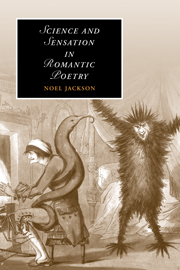Book contents
- Frontmatter
- Contents
- List of illustrations
- Acknowledgments
- List of abbreviations
- Introduction: Lyrical forms and empirical realities: reading Romanticism's “language of the sense”
- PART I SENSES OF HISTORY: BETWEEN THE MIND AND THE WORLD
- PART II SENSES OF COMMUNITY: LYRIC SUBJECTIVITY AND “THE CULTURE OF THE FEELINGS”
- PART III THE PERSISTENCE OF THE AESTHETIC: AFTERLIVES OF ROMANTICISM
- 5 John Keats and the sense of the future
- 6 More than a feeling? Walter Pater, Wilkie Collins, and the legacies of Wordsworthian aesthetics
- Notes
- Select bibliography
- Index
- CAMBRIDGE STUDIES IN ROMANTICISM
6 - More than a feeling? Walter Pater, Wilkie Collins, and the legacies of Wordsworthian aesthetics
Published online by Cambridge University Press: 22 September 2009
- Frontmatter
- Contents
- List of illustrations
- Acknowledgments
- List of abbreviations
- Introduction: Lyrical forms and empirical realities: reading Romanticism's “language of the sense”
- PART I SENSES OF HISTORY: BETWEEN THE MIND AND THE WORLD
- PART II SENSES OF COMMUNITY: LYRIC SUBJECTIVITY AND “THE CULTURE OF THE FEELINGS”
- PART III THE PERSISTENCE OF THE AESTHETIC: AFTERLIVES OF ROMANTICISM
- 5 John Keats and the sense of the future
- 6 More than a feeling? Walter Pater, Wilkie Collins, and the legacies of Wordsworthian aesthetics
- Notes
- Select bibliography
- Index
- CAMBRIDGE STUDIES IN ROMANTICISM
Summary
In discussions of the division between high art and mass culture, few notions have secured more consensus than that concerning the basis upon which we generally make such distinctions in the first place. In an argument that has proved exceedingly influential for our theoretical understanding of the so-called cultural divide, Pierre Bourdieu in Distinction described as the defining characteristic of bourgeois aesthetics “a refusal of ‘impure’ taste and of aisthesis (sensation), the simple, primitive form of pleasure reduced to a pleasure of the senses.” On this (widely shared) account, the refusal of sensation represents not merely a site but rather the primary source of the cultural divide, which has both its origin and its strongest basis in the rupture between sensuous and reflective aesthetic experience.
If the distinction between elite and popular culture is now commonly regarded having its theoretical basis in the refusal of sensation, critics are just as united in dating this refusal to the period of European Romanticism. In the widely cited “Postscript” to Distinction, Bourdieu finds the theoretical grounding for “high” literary aesthetics in the Critique of Judgment, particularly in Kant's insistence that the basis for the subjective universal validity of aesthetic experience resides not in bodily sense but rather in the higher cognitive faculties. Kant is thereby understood as having introduced a gulf between embodied aesthetic experience and the formal character of the reflective judgment – between “the taste of reflection” and “the taste of sense” – that would become the basis for all subsequent formulations of elite literary aesthetics.
- Type
- Chapter
- Information
- Science and Sensation in Romantic Poetry , pp. 197 - 220Publisher: Cambridge University PressPrint publication year: 2008



